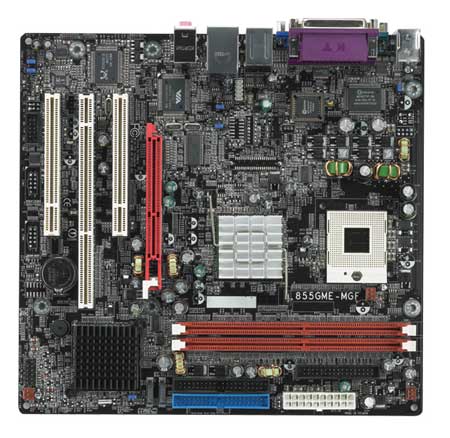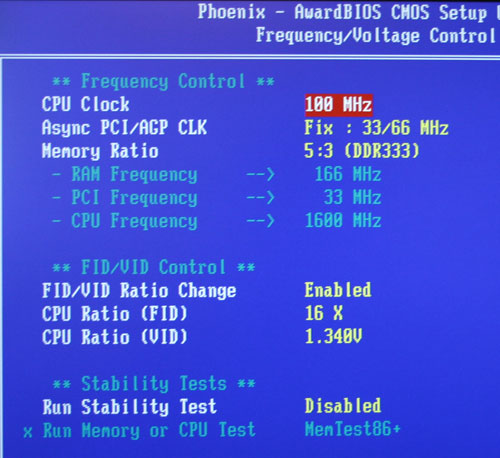Intel's Pentium M on the Desktop - A Viable Alternative?
by Anand Lal Shimpi on February 7, 2005 4:00 PM EST- Posted in
- CPUs
DFI 855GME-MGF
The DFI 855GME-MGF was originally designed for a customer who needed PCI-X support, so DFI used a server version of ICH5 that provided both PCI-X and SATA support (FWE6300ESB). The server ICH obviously contributes to the price of the board, but from what we've seen, the DFI board only commands a $10 price premium over the AOpen board.
Since it's based on the 855GME chipset, the board obviously features integrated video - but the performance is nothing to write home about. Unlike AOpen's board, there's only a single 10/100/1000 GigE port, but on the 855GME-MGF, you get a single FireWire 400 port on the I/O panel as well (instead of through a separate connector).
The 855GME-MGF only needs a 20-pin ATX power connector and no auxillary 4-pin +12V connector (unlike the AOpen board). The problem with DFI's layout, however, is the placement of a capacitor next to the 20-pin ATX power connector, which means that you can't use a 24-pin PSU with the board unless you have an adapter as the capacitor that won't let the additional 4 pins overhang.
The BIOS of the 855GME-MGF is very similar to the AOpen board in terms of options, but the actual layout for overclocking in the BIOS isn't as intuitive as it was on the AOpen board.

The stability of the DFI board was nothing to complain about, although it was far more sensitive to memory overclocking than the AOpen board was. When overclocked to the same levels that we were able to achieve on the AOpen board, the 855GME-MGF would randomly not POST between reboots. Usually a quick reboot would fix the problem, but it's still something that we'd rather not deal with. While we could easily hit 2.4GHz on the AOpen board, we found that 2.26GHz was the only stable overclock that we could achieve on the DFI motherboard (with all other variables, such as memory speed, the same).
The voltage adjustments are equally as disappointing on the 855GME-MGF. You can only adjust Vcore up to a maximum of 1.340V. And just like the AOpen board, although the 855GME-MGF only officially supports the 400MHz FSB, reaching 533MHz isn't a problem at all.
DFI's cooling solution is a little different from AOpen's, as they include a smaller but taller heatsink that screws on to a backplate. Both DFI and AOpen's fans were similarly quiet. AOpen's heatsink relied on thermal grease to improve heat transfer, while DFI's solution has a layer of thermal conductive material already on the base of the heatsink. The advantage to AOpen's method of just supplying thermal grease is that it's easier to reapply if you switch CPUs often, rather than the material that's present on the DFI heatsink.
Overall, the DFI is just as capable of a board as AOpen's solution, and is the only solution that offers a PCI-X slot if that matters to you. However, the BIOS layout, reduced stability when overclocking, and a slightly higher price point give the nod to AOpen for our overall recommendation.
The DFI 855GME-MGF currently sells for $239.










77 Comments
View All Comments
fitten - Tuesday, February 8, 2005 - link
Also, it's interesting that there are many benchmarks chosen which are known to stress the weaknesses of the Pentium-M... not that it isn't interesting information. For example, there seems to be a whole lot of FPU intensive benchmarks (around 15 or so, all of which the Pentium-M should lose handily - known before they are even run) so kind of just hammering the point home I guess.Anyway, the Dothans held up pretty well from what I can see... Most of the time (except for the notable FPU intensive and memory bandwidth intensive benchmarks), the Dothan compares quite well with Athlon64s of the same clock speed that have the advantage of dual channel memory.
fitten - Tuesday, February 8, 2005 - link
The other interesting thing about the Athlon64 vs. Dothan comparison is that even with dual channel memory bandwidth on the Athlon64's side, the single channel memory bandwidth of the Dothan still keeps it very close in many of the benchmarks and can even beat the dual channel Athlon64s at 400MHz higher clock in some.Anyway, the Pentium-M family is a good start. Some tweaking here and there (improved FPU with better FPU performance and maybe another FPU execution unit, improved memory subsystem to make good use of dual channel) and it will be at least as good as the Athlon64s across the board.
I own three Athlon64 desktops, two AthlonXP desktops, and two Pentium-M laptops and the laptops are by no means "slow" at doing work.
KristopherKubicki - Tuesday, February 8, 2005 - link
teutonicknight: We purposely don't change our test platform too often. Even though we are using a slightly older version of Premiere, it is the same version we have used in our other processor analyses.Hope that helps,
Kristopher
kmmatney - Tuesday, February 8, 2005 - link
There's also a Celeron version that would have been intersting to review. The small L2 cache should hurt the performance, though. I think the celeron version using something like 7 Watts. It would make no sense to put a celeron-M in such an expensive motherboard, though.Slaimus - Tuesday, February 8, 2005 - link
I think this indirectly shows how AMD needs to update its caching architecture on the K8. They basically carried over the K7 caches, which is just too slow when paired with its memory controller. Instead of being as large as possible (as evidenced by the exclusive caches) at the expense of latency, the K8 needs faster caches. The memory bandwith of L2 vs system memory is only about 2 to 1 on the K8, which is to say the L2 cache is not helping the system memory much.sandorski - Monday, February 7, 2005 - link
I think the Pentium M mythos can now be laid to rest.mjz5 - Monday, February 7, 2005 - link
to #29:your 2800 is the 754 pin.
the 3000+ reviewed is the 939 pin which is 1.8. the 3000+ for the 754 is 2.0 ghz
kristof007 - Monday, February 7, 2005 - link
I don't know if anyone else noticed but the charts are a bit off. My A64 2800+ is running at a stock 1.8 ghz .. while in the review the A64 3000+ is running at 1.8 ... weird!knitecrow - Monday, February 7, 2005 - link
#251) Intel and AMD measure TDP differently... and TDP is not the same as actual power dissipation. The actual dissipation of 90nm A64 is pretty darn good.
2) A microprocessor is not made of Lego... you can't rearrange/tweak parts to make it faster. It takes a lot of time, energy and talent to make changes -- even then it may not work for the best. Prescott anyone?
Frankly I’ve been waiting for a good review of P-M's actual performance. I really don't trust those "other" sites.
k00kie - Monday, February 7, 2005 - link